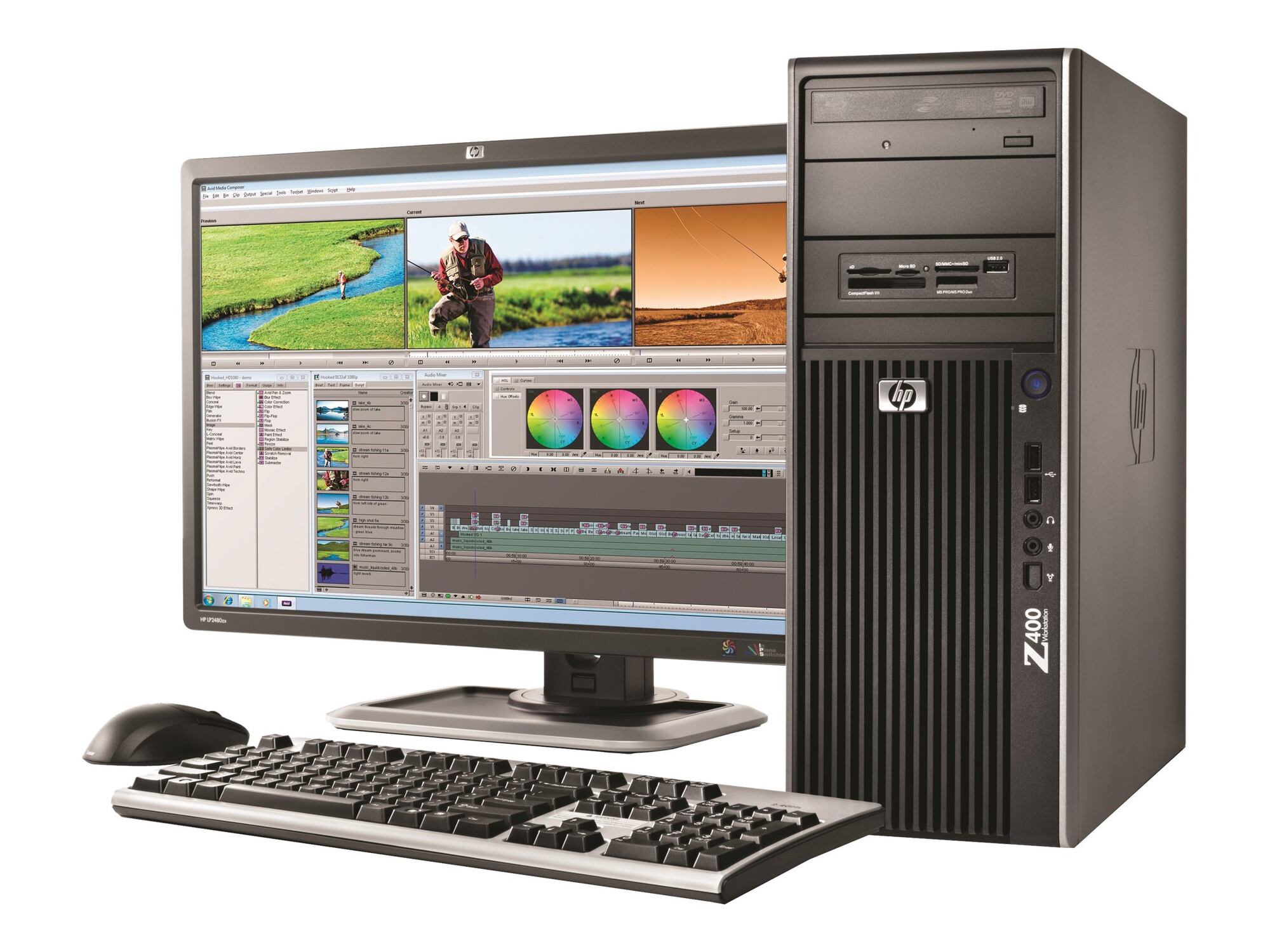Introduction
When it comes to choosing the right computing solution for your needs, you may find yourself faced with a familiar debate – Workstation vs Personal Computer (PC). While a personal computer is the typical choice for most individuals, there are certain scenarios where a workstation proves to be a more suitable option. Workstations are purpose-built machines designed to handle demanding tasks, such as graphic design, video editing, engineering simulations, and scientific research. They offer superior performance, advanced features, and enhanced reliability, making them the preferred choice for professionals in various industries.
In this article, we will explore the reasons why you might choose a workstation over a personal computer. We will delve into the specific advantages workstations offer, including their performance capabilities, multitasking abilities, memory and storage capacity, graphics and design capabilities, enhanced security and reliability, specialized applications and workloads, collaborative work environments, and overall cost and scalability.
By the end of this article, you will have a clear understanding of the benefits a workstation can bring to your work, and whether it is the right choice for your specific needs. So, let’s dive in and explore the world of workstations to determine their importance in the realm of computing.
Purpose of a Workstation
A workstation is specifically designed to fulfill the needs of professionals who require advanced computing power to handle resource-intensive tasks. Unlike personal computers that are primarily used for general computing needs, workstations are optimized for specialized applications and workloads.
One of the main purposes of a workstation is to provide exceptional performance and power. Workstations are equipped with high-performance processors, substantial amounts of RAM, and powerful graphics cards, allowing for faster data processing and seamless execution of complex tasks. Whether you’re a graphic designer working on large-scale projects, a video editor rendering high-resolution footage, or an engineer running simulations, a workstation can handle the demanding nature of these tasks with ease.
Another significant purpose of using a workstation is its multitasking and productivity capabilities. Workstations are designed to handle multiple applications simultaneously without compromising performance. This makes it possible to work on complex projects that require running resource-intensive software, such as CAD programs, data analysis tools, or 3D rendering applications. With a workstation, professionals can efficiently switch between tasks and increase their productivity without experiencing lags or delays.
Workstations also excel in terms of memory and storage capacity. They come equipped with large amounts of RAM, enabling professionals to work with extensive datasets and run memory-intensive applications smoothly. Additionally, workstations provide ample storage options, including multiple hard drives or solid-state drives (SSDs), allowing for efficient storage and retrieval of large files, such as raw video footage, high-resolution images, or complex simulations.
Furthermore, workstations are the go-to choice for professionals working in the graphics and design field. With their powerful graphics cards and support for multiple displays, workstations allow graphic designers, architects, and animators to work with high-definition visuals and create intricate designs with precision. This level of graphical prowess is unmatched by personal computers, making workstations an essential tool for those in the design industry.
In summary, the purpose of a workstation is to provide professionals with the necessary computing power, multitasking capabilities, memory and storage capacity, and graphic performance required to handle resource-intensive tasks effectively. By using a workstation, professionals can enhance their productivity, seamlessly work on specialized applications, and achieve superior results in their respective fields.
Performance and Power
One of the key advantages of using a workstation over a personal computer is the superior performance and power it provides. Workstations are built with advanced hardware components that are specifically optimized for handling resource-intensive tasks.
Workstations are equipped with high-performance central processing units (CPUs) that have multiple cores and higher clock speeds. These processors are designed to handle complex calculations and data processing at a much faster rate compared to standard CPUs found in personal computers. This makes workstations ideal for tasks that require heavy computational power, such as rendering high-resolution 3D graphics, running complex simulations, or performing data analysis.
In addition to powerful CPUs, workstations also boast larger amounts of random access memory (RAM) than personal computers. With ample RAM, workstations can hold and process vast amounts of data, allowing professionals to work with large datasets and run memory-intensive applications seamlessly. This results in quicker data retrieval and processing times, enhancing overall performance and productivity.
Another significant factor contributing to the performance of workstations is the inclusion of high-end graphics processing units (GPUs). These dedicated graphics cards are designed to handle demanding visual tasks, such as rendering complex 3D models, creating realistic visual effects, or editing high-definition videos. The powerful GPUs in workstations enable professionals in design, architecture, engineering, and entertainment industries to work with intricate visual elements and produce high-quality outputs.
Workstations also offer enhanced power efficiency, thanks to their advanced power management features. Unlike personal computers that are optimized for energy-saving functionality, workstations are built to handle sustained high-performance tasks without compromising efficiency. This means professionals can rely on their workstations to deliver consistent power and performance throughout demanding projects, ensuring smooth workflow and reducing any potential bottlenecks.
In summary, workstations provide superior performance and power compared to personal computers. The combination of high-performance CPUs, ample RAM, powerful dedicated GPUs, and efficient power management allows workstations to handle resource-intensive tasks smoothly and consistently. Whether it’s editing high-resolution videos, working with complex simulations, or running graphic-intensive applications, workstations offer professionals the computing power they need to achieve optimal performance and deliver exceptional results.
Multitasking and Productivity
Workstations are designed to excel in multitasking and boost productivity, making them an ideal choice for professionals who need to handle multiple applications and tasks simultaneously.
One of the main advantages of workstations in terms of multitasking is their powerful processors and ample RAM. With high-performance CPUs and substantial memory capacity, workstations can handle resource-intensive software and large datasets without compromising performance. This means professionals can seamlessly switch between applications, run multiple tasks concurrently, and experience smooth and responsive performance.
Whether it’s editing videos while rendering 3D graphics, running simulations alongside data analysis, or working with heavy graphic design software, workstations can handle these tasks simultaneously without lag or system slowdown. This allows professionals to optimize their workflow, increase efficiency, and complete complex projects more efficiently.
In addition to processing power, workstations also provide a wide range of connectivity options. They come equipped with multiple USB ports, Thunderbolt ports, and dedicated PCIe slots, allowing professionals to connect various peripherals and accessories. This makes it easier to connect external displays, graphics tablets, VR headsets, external storage devices, and other devices necessary for specific tasks, ultimately enhancing multitasking capabilities and overall productivity.
Moreover, workstations offer robust multitasking features at the operating system level. These systems often include advanced multitasking features like virtual desktops, allowing professionals to organize and switch between different work environments or projects easily. This feature is particularly useful when working on multiple projects simultaneously or when needing to separate work-related tasks from personal activities.
Workstations also provide efficient and seamless multitasking through their optimized software environments. These machines are often pre-configured or optimized for specific professional applications, such as CAD software, video editing software, or scientific research tools. This ensures compatibility, smooth integration, and seamless interoperability between different software tools, further enhancing productivity and reducing downtime.
In summary, workstations are designed to deliver exceptional multitasking capabilities, allowing professionals to handle multiple applications and tasks simultaneously. With powerful processors, ample RAM, diverse connectivity options, advanced multitasking features, and optimized software environments, workstations provide an efficient and seamless multitasking experience. This leads to increased productivity, better workflow management, and quicker turnaround times for complex projects.
Memory and Storage Capacity
Workstations offer a significant advantage over personal computers when it comes to memory and storage capacity. These machines are equipped with robust memory and storage options, allowing professionals to handle and process large amounts of data efficiently.
One of the key features of workstations is their ample random access memory (RAM). Workstations typically come with more RAM compared to personal computers, which enables professionals to work with large datasets and run memory-intensive applications smoothly. With higher RAM capacity, professionals can handle complex simulations, perform data analysis on extensive datasets, or run resource-intensive software without encountering performance issues or slowdowns.
Additionally, the RAM in workstations is often more advanced, with higher clock speeds and lower latency, resulting in faster data processing and access times. This allows professionals to work with large design files, manipulate high-resolution images, or process complex mathematical computations without experiencing delays or bottlenecks.
When it comes to storage capacity, workstations provide ample options to accommodate the needs of professionals dealing with large files and datasets. Workstations often come with multiple storage devices, such as solid-state drives (SSDs) and hard disk drives (HDDs), allowing for a combination of speed and capacity.
SSDs are particularly advantageous for workstations as they provide faster data access speeds compared to traditional HDDs. This means that professionals can quickly retrieve and save files, load software applications faster, and experience improved overall system responsiveness. SSDs are particularly beneficial for tasks such as video editing, 3D rendering, and working with large databases.
On the other hand, workstations often include HDDs as supplemental storage options, offering larger capacities for storing large files, archival data, or backups. HDDs are generally more cost-effective for storing large amounts of data, making them a suitable choice for professionals who require extensive storage capacities.
Workstations also often support RAID (redundant array of independent disks) configurations, which allow for data redundancy, improved performance, and increased storage capacity. By utilizing RAID, professionals can ensure the safety and availability of their critical data, as well as enhance performance by distributing data across multiple drives.
In summary, workstations excel in terms of memory and storage capacity. With their ample RAM capacity and advanced memory features, workstations can handle memory-intensive tasks and process large datasets efficiently. Additionally, the inclusion of SSDs and HDDs provides professionals with a balance of speed and capacity, allowing for faster data access and ample storage space. These features make workstations well-suited for handling the demanding storage and memory requirements of professionals in various industries.
Graphics and Design
Workstations are specifically designed to cater to the needs of professionals in the graphics and design industry. With their powerful graphical capabilities, workstations provide a superior environment for working with high-quality visuals and creating stunning designs.
One of the main advantages of workstations in terms of graphics is the inclusion of high-end graphics processing units (GPUs). These dedicated graphics cards are designed to handle demanding visual tasks with ease. Whether it’s working with large-scale 3D models, rendering high-resolution visual effects, or editing videos with precision, workstations offer the necessary graphical processing power to handle these tasks seamlessly.
The powerful GPUs in workstations can handle complex shading, lighting, and rendering algorithms, allowing graphic designers, animators, and architects to create intricate and realistic visual representations. This level of graphical prowess is unmatched by standard personal computers, making workstations an essential tool for professionals who rely heavily on visual elements in their work.
Workstations also often support multiple displays, allowing professionals to work on large-scale projects with ease. By connecting additional monitors, professionals can have an expansive workspace that enhances their productivity and workflow. This is particularly beneficial for designers and artists who require multiple windows open simultaneously to compare, edit, and manipulate various elements of a design.
In addition to raw graphical power, workstations offer advanced color accuracy and calibration options. This is crucial for professionals in fields such as graphic design, photography, and video production, where color accuracy is of utmost importance. Workstations provide the necessary tools and features to ensure precise color calibration, allowing professionals to achieve accurate and consistent colors in their designs and visual creations.
Another advantage of workstations is the availability of specialized software and drivers. Many professional design applications are optimized to run specifically on workstations, taking advantage of the powerful hardware and graphics capabilities. These optimized applications provide professionals with a more fluid and efficient workflow, ensuring that every aspect of the design process is handled with precision and clarity.
In summary, workstations offer exceptional graphics and design capabilities. With their powerful GPUs, support for multiple displays, advanced color accuracy, and specialized software optimizations, workstations provide professionals in the graphics and design industry with the necessary tools to create stunning visual representations. Whether it’s designing intricate 3D models, editing high-resolution images, or creating visually captivating animations, workstations empower professionals to push the boundaries of their creativity and deliver visually impressive results.
Enhanced Security and Reliability
Workstations offer enhanced security and reliability compared to personal computers, making them a preferred choice for professionals who prioritize data security and system stability.
One of the main advantages of workstations in terms of security is the inclusion of advanced security features. Workstations often come equipped with hardware-based security features, such as Trusted Platform Modules (TPMs), which provide encryption and secure storage for sensitive data. This ensures that data remains protected even if the system is compromised or stolen.
In addition to hardware-level security, workstations often include advanced software security measures. This can include features like secure boot, which ensures that the system starts up using only authorized and verified software, minimizing the risk of malicious code being executed during startup. Workstations may also include features such as biometric authentication options, smart card readers, and enhanced access controls, further bolstering system security.
Workstations also provide increased reliability compared to personal computers. These machines are built with high-quality components and undergo rigorous testing and quality control processes to ensure stable and dependable performance. Workstations are designed to handle heavy workloads over extended periods without experiencing system failures or crashes.
Moreover, workstations are often equipped with redundant components to minimize downtime in case of hardware failures. This can include features like redundant power supplies, multiple hard drives in RAID configurations, and error-correcting memory modules. These redundant components ensure that even if one part fails, the system can continue to operate smoothly, minimizing disruptions and ensuring uninterrupted workflow.
Workstations also benefit from better cooling systems, which help maintain optimal operating temperatures. This prevents overheating and extends the lifespan of internal components, further enhancing system reliability. Professional-grade workstations are often designed with improved airflow and advanced cooling mechanisms, such as liquid cooling, to dissipate heat efficiently and keep the system running at peak performance.
Furthermore, workstations typically come with comprehensive manufacturer support and warranty options. This ensures that professionals have access to timely technical support and assistance if any issues arise. Workstations are often backed by longer warranties compared to personal computers, giving professionals peace of mind and assurance when investing in these machines.
In summary, workstations offer enhanced security and reliability compared to personal computers. With advanced security features, redundant components, superior cooling systems, and comprehensive manufacturer support, workstations provide a secure and dependable environment for professionals to work on their critical projects. Whether it’s protecting sensitive data or ensuring system stability, workstations are designed to meet the demanding needs of professionals who require a secure and reliable computing solution.
Specialized Applications and Workloads
Workstations excel in handling specialized applications and workloads, making them the go-to choice for professionals in various industries. These machines are optimized to deliver exceptional performance and reliability for specific tasks, ensuring that professionals can work efficiently and effectively in their respective fields.
One of the main advantages of workstations is their compatibility and optimization for specialized software applications. Workstations are designed to run resource-intensive applications smoothly, such as computer-aided design (CAD) software, video editing tools, 3D modeling and rendering software, scientific simulations, engineering analysis tools, and more. The powerful hardware components and optimized software configurations of workstations ensure that professionals can work on these applications without experiencing lag or performance issues.
In addition to the compatibility with specialized software, workstations are built to handle specific workloads that require significant computing power. For example, professionals in the scientific research community may need to run complex simulations, perform data analysis on large datasets, or process high-performance computing (HPC) workloads. Workstations can handle these demanding tasks efficiently and effectively, allowing researchers to make progress in their studies and gain valuable insights from their work.
Another area where workstations shine is in industries such as architecture, engineering, and construction (AEC). These professionals require robust workstations that can handle the intricate nature of building models, perform structural analysis, and render detailed visualizations. Workstations provide the necessary computing power and graphics capabilities to handle these tasks, ensuring smooth workflows and accurate representations of architectural designs.
Professionals in the media and entertainment industry also benefit greatly from using workstations. The demands of video editing, animation, and visual effects require powerful workstations to handle the extensive processing involved. Workstations provide the necessary processing power, high-capacity storage, and advanced graphics capabilities to seamlessly handle rendering high-resolution video footage, creating complex visual effects, and managing large media libraries.
Workstations are also widely used in the healthcare and medical fields. Professionals in this industry rely on workstations for tasks such as medical imaging analysis, data-intensive research, and advanced 3D visualization of patient data. The computing power and specialized hardware configurations of workstations enable healthcare professionals to process and interpret medical data accurately, leading to improved diagnosis and treatment outcomes.
In summary, workstations are purpose-built machines that excel in handling specialized applications and workloads. From CAD software and video editing tools to scientific simulations and medical imaging analysis, workstations provide the necessary computing power and optimized configurations to ensure professionals can work efficiently and effectively in their respective fields. Whether it’s performance-demanding tasks in research, design, media, or healthcare, workstations are designed to meet the unique needs of these specialized applications and workloads.
Collaborative Work Environment
Workstations offer advanced features and capabilities to facilitate a collaborative work environment, making them ideal for professionals who rely on teamwork and cooperation for their projects. These machines enhance collaboration through improved connectivity, shared resources, and efficient communication tools.
One of the key features of workstations that contribute to a collaborative work environment is their extensive connectivity options. Workstations come equipped with multiple USB ports, Thunderbolt ports, and other connectivity options, allowing professionals to connect and share data with ease. This facilitates the smooth transfer of files, sharing of resources, and collaboration between team members.
Workstations also often have multiple display outputs, allowing professionals to connect multiple monitors and share their screens. This is particularly useful in design, architecture, and engineering industries where visual collaboration is crucial. Being able to view and discuss designs, plans, or simulations simultaneously enhances communication and streamlines the decision-making process.
Additionally, workstations often have powerful networking capabilities. They come equipped with high-speed Ethernet ports and support for Wi-Fi connectivity, enabling professionals to connect to local area networks (LANs) or cloud-based collaboration tools. This allows for seamless file sharing, real-time collaboration, and remote access capabilities, enabling teams to work together efficiently, regardless of their physical location.
Workstations also offer optimized software and applications specifically designed for collaboration. This can include virtual meeting platforms, project management tools, and cloud-based file-sharing systems. These software tools allow team members to communicate, share updates, assign tasks, and collaborate on projects in real-time, facilitating efficient teamwork and ensuring everyone is on the same page.
Furthermore, workstations often come with advanced security features that are essential in a collaborative work environment. These security measures include secure data encryption, access control features, and secure remote access options. This ensures that sensitive data remains protected, even when collaborating with team members outside the physical workspace.
In summary, workstations are designed to enhance collaboration in the workplace. The extensive connectivity options, support for multiple displays, powerful networking capabilities, optimized collaboration software, and advanced security features make workstations a perfect choice for professionals who rely on a collaborative work environment. By leveraging these collaborative features, teams can work together seamlessly, share resources efficiently, and communicate effectively, resulting in improved productivity and successful project outcomes.
Cost and Scalability
When considering the choice between workstations and personal computers, cost and scalability are important factors to consider. While workstations generally have a higher upfront cost compared to personal computers, they offer unique advantages in terms of scalability and long-term cost-effectiveness.
Workstations are designed for high-performance tasks and are built with powerful hardware components, which often come at a higher price point. However, the initial investment in a workstation can prove to be cost-effective in the long run due to their longevity and scalability.
One aspect that sets workstations apart from personal computers is their scalability. Workstations are built to be easily customizable and upgradable, allowing for the addition of more powerful components as needed. This scalability extends the lifespan of workstations, as they can be adapted to meet changing technological requirements and evolving workloads.
For professionals who anticipate the need for additional processing power or storage capacity in the future, workstations offer the flexibility to upgrade components such as CPUs, GPUs, RAM, and storage devices. This eliminates the need to purchase an entirely new system and allows for a more cost-effective approach to meeting increased performance demands.
Moreover, workstations often have longer lifecycles compared to personal computers. The robust build, high-quality components, and optimized software environment make workstations more durable and reliable over an extended period. This translates to reduced downtime and maintenance costs, as professionals can rely on their workstations to withstand heavy workloads without encountering frequent hardware failures or system crashes.
In terms of software costs, while workstations may require specialized software, the benefits they provide in terms of performance and optimized workflows can offset these additional expenses. The improved productivity and efficient processing capabilities of workstations can result in higher quality outputs and faster project completion times, ultimately leading to cost savings for businesses and professionals.
It’s also worth mentioning that workstations often come with comprehensive manufacturer warranties and technical support options. These services can further contribute to long-term cost-effectiveness by minimizing the costs associated with system maintenance, repairs, and troubleshooting.
On the other hand, personal computers may offer a lower upfront cost, but they may not have the same level of performance, reliability, and scalability as workstations. Personal computers are typically designed to meet general computing needs and may not have the capacity to handle the demanding tasks required by professionals in specialized industries.
In summary, while workstations may come with a higher initial cost, their scalability, durability, and optimized performance make them a cost-effective choice for professionals in the long run. The ability to upgrade components, extended lifecycles, and comprehensive manufacturer support contribute to the overall cost-effectiveness of workstations. While personal computers may have a lower upfront cost, they may lack the performance, reliability, and ability to scale that workstations offer.
Conclusion
Choosing between a workstation and a personal computer depends on your specific needs and requirements. Workstations provide numerous advantages over personal computers, particularly in terms of performance, multitasking capabilities, memory and storage capacity, graphics and design capabilities, enhanced security and reliability, support for specialized applications and workloads, collaborative work environments, and scalability.
Workstations are purpose-built machines that are designed to handle resource-intensive tasks and demanding workloads. They offer superior performance, advanced hardware components, and optimized software environments, making them the preferred choice for professionals in various industries.
When it comes to performance, workstations excel with their high-performance processors, substantial amounts of RAM, and powerful graphics cards. They can handle complex calculations, process large datasets, and render graphics with ease.
Workstations also enhance productivity and efficiency with their ability to multitask seamlessly. Professionals can run multiple resource-intensive applications simultaneously without compromising performance, allowing for smoother workflow and increased productivity.
The memory and storage capacity of workstations enable professionals to work with extensive datasets and run memory-intensive applications without encountering bottlenecks. The inclusion of high-capacity RAM and various storage options, such as SSDs and HDDs, provides professionals with efficient data processing and extensive storage capabilities.
In the field of graphics and design, workstations offer powerful GPUs, support for multiple displays, and advanced color accuracy. These features enable professionals to work with intricate visual elements, create realistic representations, and achieve accurate color reproductions in their designs.
Workstations prioritize security and reliability by incorporating advanced security features, utilizing redundant components, and offering comprehensive technical support. These machines ensure data protection, system stability, and minimize downtime, which is crucial for professionals working on critical projects.
Specialized applications and workloads find a perfect match in workstations, as they provide the necessary processing power and software optimizations. Workstations are designed to handle applications such as CAD software, video editing tools, scientific simulations, and medical imaging analysis, allowing professionals to work efficiently in their respective industries.
Workstations also foster a collaborative work environment through enhanced connectivity options, shared resources, and specialized collaboration software. Professionals can easily share data, collaborate in real-time, and communicate efficiently, regardless of their physical location.
While workstations often come with a higher upfront cost, they offer scalability, longevity, and cost-effectiveness in the long run. The ability to upgrade components and extended lifecycles make workstations adaptable to evolving technological demands, minimizing the need for complete system replacements.
In conclusion, workstations provide professionals with the necessary power, capabilities, and reliability to handle specialized tasks and achieve exceptional results. Whether you’re in the design industry, scientific research field, media and entertainment sector, or any other profession requiring high-performance computing, workstations offer the ideal solution to meet your needs and propel your work to new heights.

























